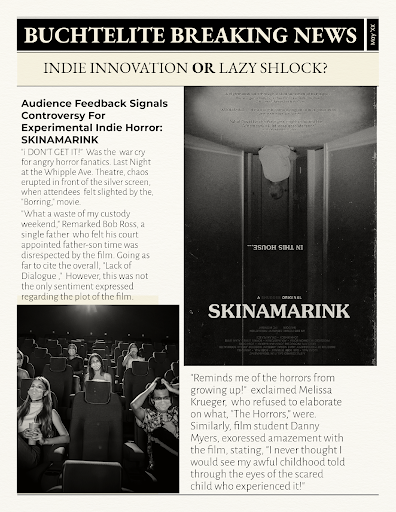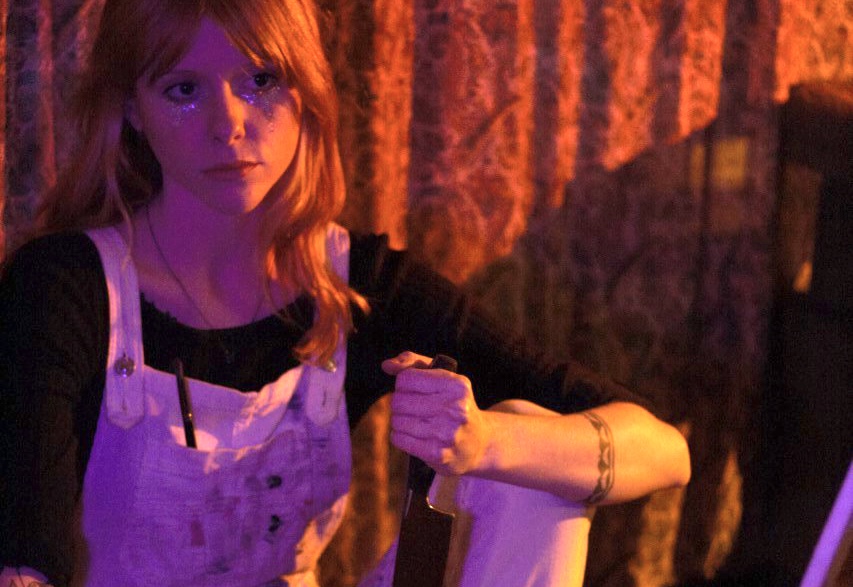This film has been the subject of endless online debate. I’ve read stories of full theatres transforming into barren ghost towns, every patron walking out of the slow, “plotless” film. I’ve also heard tales of terror where audiences are left disturbed to their core.
Directed by Kyle Edward Ball, Skinamarink is a Canadian experimental horror film derived from Ball’s 2020 short film, “Heck.” The $15,000 budget of “Skinamarink” was mostly crowdfunded and was shot over a seven-day period in Ball’s childhood home in Edmonton, Canada. From what I’ve read, this sounds like a true independent production from the lighting to the props. Ball cites that most of the light source came from an old box TV and credits his mother for keeping his childhood toys seen in the film. The largest contribution that allowed for such a low budget came from The Film and Video Arts Society of Alberta as most of Skinamarink’s equipment was borrowed from the organization.
The title itself has been cause for speculation. What is a Skinamarink? The word is derived from the nursery song called, “Skid-dy-mer-rink-adink-aboomp” later titled, “Skidamarink” and, “Skinnamarink.” Since the title is gibberish, it has had multiple variations over the years. This story inspired Ball to research further, explaining in an interview with Jezebel how it felt personal to him by evoking childhood. Drawn by the word’s public domain status, Ball altered the spelling for his title to avoid young children finding his movie when searching for the song online.
The plot: Siblings Kevin (Lucas Paul) and Kaylee (Dali Rose Tetreault) wake up to discover that the windows, doors and other objects in their home are disappearing. Their father is gone. Kevin later suggests he may have “went with mom” but Kaylee avoids the topic. Slow, grainy shots of empty rooms and darkened doorways are all shot from low angles, representing the point of view of a child.
The camera cuts to a ceiling shot and, presumably, the children’s father is heard having a conversation.
“So…he’s fine…but, Kevin fell down the stairs and hit his head…mhm…No, they didn’t even need to do stitch-” cutting off as the shot cuts to a different dark room.
The same voice is heard whispering, “Kaylee said he was sleepwalking,” More slow dark shots proceed, and the children are shown walking from a well-lit hallway to a dark room several times, calling out for their father.
A shot of window blinds pulled all the way up reveals a blank wall as Kevin questions, “Where did it go?”
Unsure of what to do, they decide to sleep downstairs in front of the TV. This is followed by uncomfortable, low angle shots of darkened doorways, hallways and a toilet reappearing and disappearing again. One, or both, of the children tries making a phone call. The touch tones of the phone can be heard seven times following a short pause. The phone is hung-up shortly before being picked back up and three touch tones can be heard, a longer pause follows and the phone is hung up. The camera cuts to what appears to be a different room with a different landline and three touch tones are heard followed by a low beep. The touch tones are quickly repeated along with the low beep.
Since this movie inspires such a strong response in either direction, I won’t be spoiling the ending. I encourage people to watch it themselves and determine what they think this movie is trying to say. I will give my thoughts and reasoning as much as I can without explaining the ending.
Personally, I think Skinamarink is an allegorical film centered around an abusive or otherwise unstable home. I interpreted much of the film’s visual style and slow burn static shots as a child’s nightmare that they don’t fully remember. I think this is where the audience disconnect comes in. Children have a different idea of what is scary compared to adults. This aspect is seen in the film’s many dark doorways with the unknown of what is on the other side. The absence of light works as a dark cloak, hiding a monster within it. The film centers itself around the point of view of Kevin and Kaylee, acting as frightened children would in their situation. Due to a child’s lack of understanding, something scary would be interpreted differently than it would by an adult.
The dialogue we hear about Kevin falling down the stairs sounds like the father’s side of a phone conversation. He sounds like he is talking to someone that would need to know about Kevin’s injury, most likely his mother. I don’t think Kevin’s suggestion that his father “went with mom” was meant to hint at her death. I believe their mother is in the hospital due to a physical or mental illness. As for the father’s recollection as to how the accident happened, I have a few ideas. The obvious being that the father was lying and pushed Kevin down the stairs. Assuming he’s being truthful, high levels of emotional/physical stress or fatigue in children are known to cause sleepwalking. There is also a hereditary component. This could be Ball’s way of hinting at the children’s turbulent home life.
I think Kevin or Kaley attempted to call their father or mother and couldn’t remember the full number, which would have been 10 touch tones not seven. The realization of this might scare a young child into dialing the only other number they know: 911. This would match the three tones made during the second, third and fourth call. I think the phones are not working, signaled by the low beeps as a dial tone or busy signal. Another possibility that came to mind for me is that Kaylee may have started dialing her mother’s number, before remembering she died or is unable to answer her phone. If the children are suffering abuse or neglect from their father, he wouldn’t come to mind as a comforting figure.
What sways me more in the direction of the father being abusive or neglectful, is how the children look for him. They call out for him several times, but they are few and far between. Additionally, they don’t sound immediately panicked as if it’s odd for them to wake up to a dark, empty house. To me, they sound wary of what will happen when he reappears. The long spans of time between dialogue filled with unidentifiable sounds suggests frightened children waiting for someone to tell them everything is safe. If you’ve never experienced this type of anxiety and discomfort as a small child trying to distract your brain with other things, you will be bored by this. The tension of waiting and listening, unsure of what you see in the dark, is a specific type of fear.
I’ve asked nearly everyone I know their opinion on Skinamarink, and I’ve observed a correlation. If you’ve experienced a stressful or otherwise traumatizing childhood, this film is effective at what it’s trying to accomplish. Skinamarink can dig up feelings reminiscent of that time in your life. It creeps you out in a way you forgot was possible. To risk sounding pretentious, if you get it, you get it. If you had a safe or otherwise normal childhood, Skinamarink will bore and annoy you.
I also learned, the majority of people in question didn’t realize they were seeing an experimental horror film. I can understand why seeing this film out of context would damper its appeal. Essentially, it’s an indie film that managed to reach its target audience and then some. The opinion of the some usually varies.




















Lisa Craig • Oct 3, 2023 at 4:00 PM
I watched this over the weekend, not sure how I felt. It’s different, so bravo!! Challenging to follow the POV of a child but it makes sense and puts us in a very different seat. I wonder if Kevin went into a coma after his fall?